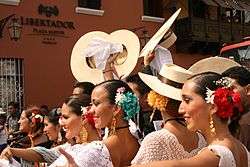Peruvians
Peruvians (Spanish: Peruanos) are people identified with the country of Peru. There were Andean and Coastal Ancient civilizations like Caral, the oldest civilization of Peru and the Americas, who inhabited Peruvian territory for several millennia before the Spanish Conquest in the 16th century; Peruvian population decreased from an estimated 5–9 million in the 1520s to around 600,000 in 1620 mainly because of infectious diseases.[13] Spaniards and Africans arrived in large numbers in 1532 under colonial rule, mixing widely with each other and with Native Peruvians. During the Republic, there has been a gradual immigration of European people (especially from Spain and Italy, and in a less extent from Germany, France, the Balkans, Portugal, and British Isles). Chinese and Japanese arrived in large numbers at the end of the 19th century.
 | |
| Total population | |
|---|---|
| c. 35.2 million Diaspora 2.1 million | |
| Regions with significant populations | |
(2019 estimate) | |
| 626,789[1] | |
| 319,183[2] | |
| 266,244[3] | |
| 120,000[4] | |
| 109,668 | |
| 98,974 | |
| 60,000 | |
| 34,385[5] | |
| 22,002[6] | |
| 20,000 | |
| 9,000[7] | |
| 8,009[8] | |
| 6,427[9] | |
| 5,886 | |
| 5,000 | |
| 4,042[10] | |
| 1,590[11] | |
| Languages | |
| Spanish • Quechua • Aymara, Peruvian Spanish | |
| Religion | |
| Predominantly: 76.03% Catholicism Minorities: 5.09% Irreligion, 14.07% Evangelical, 1.64% Non-denominational Christian, 1.52% Adventist, 0.75% Jehovah's Witness, 0.49% Mormon and 0.41% Other[12] | |
With 31.2 million inhabitants according to the 2017 Census, Peru is the fifth most populous country in South America.[14] Its demographic growth rate declined from 2.6% to 1.6% between 1950 and 2000; population is expected to reach approximately 46 - 51 million in 2050.[15] As of 2017, 79.3% lived in urban areas and 20.7% in rural areas.[16] Major cities include Lima, home to over 9.5 million people, Arequipa, Trujillo, Chiclayo, Piura, Iquitos, Huancayo, Cusco and Pucallpa, all of which reported more than 250,000 inhabitants.[17] The largest expatriate Peruvian communities are in the United States (Peruvian Americans), South America (Argentina, Chile, Venezuela and Brazil), Europe (Spain, Italy, France and the United Kingdom), Japan, Australia and Canada.
Ethnic Peruvian Structure
In the 2017 Census, those of 12 years old and above were asked what ancestral origin they belong to with 60.2% of Peruvians self-identified as Mestizos, 22.3% as Quechuas, 5.9% as White, 3.6% as Afro-Peruvian, 2.4% as Aymaras, 0.3% as Amazonians, 0.16% as Asian.[18] Indigenous people are found in the southern Andes, though a large portion, also to be found in the southern and central coast due to the massive internal labor migration from remote Andean regions to coastal cities, during the past four decades.
Mestizos
Mestizos compose 60.2% of the total population. The term traditionally denotes the ethnic Peruvian mixed with European ancestry (mostly Spanish ancestry). This term was part of the caste classification used during colonial times, whereby people of exclusive Spanish descent who were born in the colonies were called criollos, people of mixed indigenous and Spanish descent were called mestizos, those of African and Spanish descent were called mulatos, and those of indigenous and African descent were called zambos. Most mestizos are urban dwellers and show stronger European inheritance in regions like Lima Region, La Libertad Region, Callao Region, Cajamarca Region, Piura Region, Lambayeque Region, and Arequipa Region.
Ethnic groups of Peruvian origin
Ethnic groups of Peruvian origin constitute 24% of the total population.[18] The two major ethnic groups are the Quechuas (belonging to various cultural subgroups), followed by the Aymara, mostly found in the extreme southern Andes. A large proportion of the ethnic groups who live in the Andean highlands still speak Quechua and have vibrant cultural traditions, some of which were part of the Inca Empire.
Dozens of Peruvian cultures are also dispersed throughout the country beyond the Andes Mountains in the Amazon basin. This region is rapidly becoming urbanized. Important urban centers include Iquitos, Nauta, Puerto Maldonado, Pucallpa and Yurimaguas. This region is home to numerous ethnic groups, though they do not constitute a large proportion of the total population. Examples of ethnic groups residing in eastern Peru include the Shipibo, Urarina,[19] Cocama, and Aguaruna. There is no special law for ethnic groups or reserves; they are Peruvians and legally treated as such. There are some tribal communities especially in the Amazon but it is their own choice of lifestyle; they have the right to choose their place of residence, they have the freedom to live and travel, to enter and leave the country, with few limitations due to health issues or by order of a judge or international migration laws, supported by the Peruvian Constitutions and International Human Rights, they do have representation in the Congress as any other Peruvian community.
European

European descendants total 5.9% of the total population. According to the 2017 Ethnic Authentication Census, in Peru, unlike several Latin countries, only blond and light-eyed people are considered white; many white Peruvians of Mediterranean origin are considered mestizos. Most of them are descendants of the colonizers Spanish and other Europeans like Italians, Germans, British, French, Irish, Dutch, Portuguese, Polish and Croats that arrived in the 19th and 20th centuries. Most of them also live in the largest cities, generally in the northern cities of Peru: Trujillo, Chiclayo and Piura and also in the capital Lima.
The city of Arequipa in the south of Peru displays the majority of Spanish descendants in the south. Cajamarca in the highlands, parts of San Martin in the Amazon Area; Also Oxapampa and Pozuzo were populated by German and Austrian settlers in the Andes. A considerable European population migrated to Peru, they came for oil, mining, fishing, sugar, cotton, guano, rubber, and other booming industries in the mid-1800. Recently, Peru has seen an inmigration of American senior citizens and businessmen looking for permanent residency to settle in the country, due to inexpensive living, tasty fresh food, gastronomy, friendly people, excellent mild weather, beautiful ocean views, Amazon forest environment, freedom in many aspects compared with other countries, and how easy it is to do business in Peru due to economic booms from 2000 to the present. Also, people from other Latin American countries like Venezuela approximately one million people migrated Peru due to socio-economical issues, Colombians, Argentinians and Spanish people looking for better employment opportunities in late 2010.
Afro-Peruvian
Afro-Peruvians, constitute a 3.6%[20]of the population, Peru as a Spanish colony in the Conquista has a history of slave trading, from Ghana, Angola, Nigeria, Republic of Congo, Democratic Republic of Congo, Mozambique, and Madagascar. During the colonial period to perform labor work in sugar cane, cotton fields and vineyards, very few of them in gold mines in Cuzco. The Spaniards brought 500 Africans from Guinea as part of the troops for the Conquista by 1531. Slavery in Peru was abolished in 1854 by President Ramon Castilla. Today also mulatos (mixed African and European) and zambos (mixed African and indigenous) constitute an important part of the population as well, especially in Piura, Tumbes, Lambayeque, Lima and Ica regions. The Afro-Peruvian population is concentrated mostly in coastal cities south of Lima, such as those found in the Ica Region, in cities like Cañete, Chincha, Ica, Nazca and Acarí in the border with the Arequipa Region. The African descendants brought their own dances and drumming music style, creating some instruments like the "Cajon" and some culinary art characterized by their delicious taste. Some of the best soccer players in Peru are Afro-descendants. One of the most untouchable unmixed African population is still today El Carmen en Chincha Alta Ica, Peru.
Another large but less promoted segment of Afro-Peruvian presence is in the Yunga regions (west and just below the Andean chain of northern Peru), (i.e., Piura and Lambayeque), where sugarcane, lemon, and mango production are still of importance. Important communities are found all over the Morropón Province, such as in the city of Chulucanas. One of them is Yapatera, a community in the same city, as well as smaller farming communities like Pabur or La Matanza and even in the mountainous region near Canchaque. Further south, the colonial city of Zaña or farming towns like Capote and Tuman in Lambayeque are also important regions with Afro-Peruvian presence.
Asian
There is also a large presence of Asian Peruvians, Chinese and Japanese along with other Asian immigrants, that constitutes a 0.16% of the population. Peru learned the Cuban model of bringing Asian workers mostly Chinese workers.
Peru has the largest population of Chinese descendants in Latin America since Peru became independent from Spain in 1821 it was forbidden the imports of slaves. The first group of Asians came in 1849 in the Danish ship named Federico Guillermo to replace slavery that was part of the plan to abolished slavery in 1854 with Asian labor force, this was part of a transition from slavery to free worker, during the next 25 years 100,000 Chinese arrived to Peru, they were hired in eight-year contracts from Macao, Hong Kong, Canton, and Fujian, some Sangley people mixed Chinese and Filipino. They were hired for sugar cane fields, rice fields, extracting guano and constructing the railroads in the Andes. In reality, was semi-slavery working conditions. Geographically Chinese descendants communities are found throughout the Peruvian upper Amazon, including cities such as Yurimaguas, Nauta, Iquitos and the north-central coast (Lambayeque and Trujillo) and the capital Lima. Nowadays there are no biases against Chinese people like in mid-1800 from landlords, unions, instead, they became one of the most beloved people that settled in the country, for being the majority, their modesty, hard work, and their "chifa" restaurants fascinated Peruvians all over the country, including remote parts of the Andes. Peru has the second-largest population of Japanese descendants after Brazil. In these ships there were some people from India, Pakistan and Sri Lanka also, all these workers were called "Coolies" in the Hindi language meaning porters at railway stations in the 20th century, the word was brought by Sri Lankans, afterward meaning indentured laborer from South Asia, South East Asia or China, They did not stay in the country for many years, they moved mostly to developed countries with exception of the Chinese.
In contrast to the Japanese community in Peru, the Chinese appear to have intermarried much more since they came to work in the rice fields during the Viceroyalty and to replace the African slaves, as laborers during the abolition of slavery itself. Despite the presence of Peruvians of Asian heritage being quite recent, in the past decade, they have made significant advancements in business and political fields; a past president (Alberto Fujimori), several past cabinet members, and one member of the Peruvian congress are of Chinese or Japanese origin. Large numbers of Arab Peruvians, mostly Palestinians, Lebanese, Syrians, Iraqis They established their own textile industries, commerce, and entrepreneurial businesses, there is also a small Jewish community of Ashkenazis and Sephardi. All these diasporas are always welcome to Peru and are a part of our mixed heritage and culture, the diplomatic relations between these communities and Peruvians are excellent in the socio-economic and cultural aspects of life, all these diasporas are considered Peruvians also.
Immigration after independence
After independence, there has been a gradual European immigration from Spain, Italy, Croatia, France, Germany, and Austria.[21] Chinese arrived in the 1850s as a replacement for slave workers in the sugar plantations of the north coast and have since become a major influence in Peruvian society.[22] Other immigrant groups include Japanese, Arabs, South Asians, and Americans from the United States.
Languages
Castilian Spanish, is the main language of 82.6% majorly spoken in the Coastal cities, It is the primary language of the country used for the public media, television, radio, newspapers, internet in general with very minimal exceptions. It coexists with several indigenous languages, the most common Quechua,13.9% and Aymara 1.6%, both spoken mostly in the Andes, Ashaninka 0.3% in the Rainforest. Other native and foreign languages were spoken at that time by 0.8% and 0.2% of Peruvians, respectively.[23] Literacy was estimated at 94.2% in 2017; this rate is lower in rural areas (83%) than in urban areas (96.8%).[24]
Religions
Catholic 60 %, Christian 14.6 %, Other 3%, non-religious 4 %, unspecified 21.1 %. Lord of Miracles is a mural painted by an Angolan slave in the 17th century of Jesus Christ that is venerated in Lima and the main Catholic festivity in Peru and one of the biggest processions around the world. Every year, in October, hundreds of thousands of pilgrims from all walks of life, dress in purple to celebrate the also known "Black Christ" in a religious procession through the streets of Lima. The story tells that some earthquakes in Lima during the 17th and 18th Centuries destroyed most of the city leaving only that mural that was painted by the Angolan slave in 1651 was the only standing wall after the quakes in 1655,1687 and 1746 8.6 magnitude earthquake. These facts contributed to the growth and the solidification of devoted veneration to the mural known as "Christ of Pachacamilla"
Culture
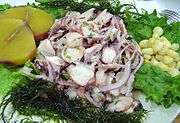
Peruvian culture is primarily rooted in Inca traditions,[25] It has also been influenced by various European, African, Asian, ethnic groups after Conquest Peruvian artistic traditions date back to the elaborate pottery, textiles, jewelry, and sculpture of Pre-Inca cultures. The Incas maintained these crafts and made architectural achievements including the construction of Machu Picchu. Baroque dominated colonial art, though modified by native traditions.[26] During this period, most arts focused on religious subjects; the numerous churches of the era and the paintings of the Cuzco School are representative.[27] Arts stagnated after independence until the emergence of Indigenismo in the early 20th century.[28] Since the 1950s, Peruvian art has been eclectic and shaped by both foreign and local art currents.[29] The Peruvian culture today is modern with global influences, always open to new trends and is constantly moving and changing in Music, Art, Literature. Peruvians are expressive, using hand gestures when talking and are tactile, expecting a kiss on the cheek for hi and bye. It is not uncommon to see couples showing affection in public places. Peruvians also have respect for elders, people of higher positions at work, skilled professionals and educated people.
Literature
Peruvian literature has its roots in the oral traditions of pre-Columbian civilizations. Spaniards introduced writing in the 16th century; colonial literary expression included chronicles and religious literature. After independence, Costumbrism and Romanticism became the most common literary genres, as exemplified in the works of Ricardo Palma.[30] In the early 20th century, the Indigenismo movement produced such writers as Ciro Alegría,[31] José María Arguedas,[32] and César Vallejo.[33] During the second half of the century, Peruvian literature became more widely known because of authors such as Nobel laureate Mario Vargas Llosa, a leading member of the Latin American Boom.[34] María Jesús Alvarado Rivera was a Peruvian rebel feminist, educator, journalist, writer and social activist who was noted by the National Council of Women of Peru in 1969 as the "first modern champion of women's rights in Peru".[35]
Architecture
Macchu Picchu, one of the seven wonders of the world, Sacsayhuaman, Chan chan, the architecture was constructed to congregate hundreds if no thousands of peoples for ceremonies and to cohabit in harmony with others and with nature. Some of the highlights were the development in acoustics, aqueducts, silos to preserve grains, the terraces, the perfection fitting the giant's boulders of 20 tons perfectly, astronomical observatories, the perfection with the solstice, the construction of entrances for the sunlight denoting meaning for every season, some of these constructions until today do not have logical human explanation, on how they were constructed.
Cuisine
Peruvian cuisine It is one of the most delicious gastronomy in the world with strong influences from Andean, Spanish, Chinese, Italian, Arab, African, and Japanese cooking.[36] Common dishes include anticuchos, ceviche and pachamanca. Because of the variety of climates within Peru, a wide range of plants and animals are available for cooking.[37] Peruvian cuisine has an especial ingredient that gives the flavor to the majority of dishes "aji seco" if the same dish is prepared in another part of the world it might look the same, but the raw vegetables, potatoes, ingredients have a different taste in other parts of the world. Examples of these are the eggs, quinoa, Lima beans, the fish, the lime more acidic, they taste totally different in other countries. Peru gave to the world the potatoes with more than 3000 species, introduced to Europe by the Spaniards in 1532 after the Conquista the Quinoa, both from the highlands. Peruvians were harvesting potatoes between 8000-5000 years according to scientific research.
Music
Peruvian music has Andean, Spanish and African roots.[38] In pre-Hispanic times, musical expressions varied widely from region to region; the quena and the tinya were two common instruments.[39] Spanish conquest brought the introduction of new instruments such as the guitar and the harp, as well as the development of crossbred instruments like the charango.[40] African contributions to Peruvian music include its rhythms and the cajón, a percussion instrument.[41] Peruvian folk dances include marinera, tondero and huayno.[42]
See also
Gallery
 Peruvian girl.
Peruvian girl.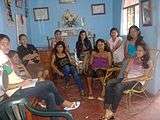 Peruvian women in Iquitos.
Peruvian women in Iquitos.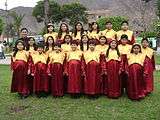 Children choir from El Agustino
Children choir from El Agustino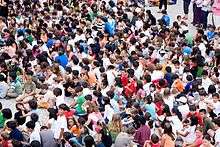 Children at an elementary school in Santiago de Surco, Lima
Children at an elementary school in Santiago de Surco, Lima
References
- "Hispanic or Latino origin by specific origin: 2014 American Community Survey 1-Year Estimates". United States Census Bureau. 2014. Archived from the original on 14 February 2020. Retrieved 25 July 2016.
- "SÍNTESIS ESTADÍSTICA DE RADICACIONES" (PDF). 2014. Retrieved 5 December 2016.
- "Extranjeros en Chile superan el millón 110 mil y el 72% se concentra en dos regiones: Antofagasta y Metropolitana" (in Spanish). El Mercurio. 9 April 2018.
- "La colonia peruana en España se redujo 15% en 6 meses" [Peruvian colony in Spain fell 15% in 6 months] (in Spanish). Elcomercio.pe. 11 December 2014. Retrieved 24 July 2016.
- "Elecciones Perú 2016: más de 13.000 ciudadanos podrán votar en Quebec y Ontario" [Peru Elections 2016: more than 13,000 citizens may vote in Quebec and Ontario] (in Spanish). Nmnoticias.ca. 8 April 2016. Retrieved 24 July 2016.
- "PERÚ Instituto Nacional de Estadística e Informática". inei.gob.pe.
- "Anzahl der Ausländer in Deutschland nach Herkunftsland (Stand: 31. Dezember 2014)".
- "Befolkning efter födelseland, ålder, kön och år". www.scb.se. Statistiska Centralbyrån. Retrieved 23 February 2020.
- "20680-Ancestry (full classification list) by Sex - Australia". Australian Bureau of Statistics. 2006. Archived from the original on 10 March 2008.CS1 maint: unfit url (link)
- Fuente — Sección de Estadística. DANE 2005."?". Retrieved 23 May 2013.
- "Bevölkerung nach Staatsangehörigkeit und Geburtsland" [Population by citizenship and country of birth] (in German). Statistics Austria. 22 June 2016. Retrieved 24 July 2016.
- "Perú: Perfil Sociodemográfico" (PDF). Instituto Nacional de Estadística e Informática. p. 231.
- Demographic collapse: Inca civilization, 1520–1620
- "Perú: Perfil Sociodemográfico" (PDF). Instituto Nacional de Estadística e Informática. p. 13.
- Instituto Nacional de Estadística e Informática, Perú: Estimaciones y Proyecciones de Población, 1950–2050, pp. 37–38, 40.
- "Perú: Perfil Sociodemográfico" (PDF). Instituto Nacional de Estadística e Informática. p. 15.
- "Perú: Perfil Sociodemográfico" (PDF). Instituto Nacional de Estadística e Informática. p. 27.
- "Perú: Perfil Sociodemográfico" (PDF). Instituto Nacional de Estadística e Informática. p. 214.
- Dean, Bartholomew 2009 Urarina Society, Cosmology, and History in Peruvian Amazonia, Gainesville: University Press of Florida ISBN 978-0-8130-3378-5
- "Perú: Perfil Sociodemográfico" (PDF). Instituto Nacional de Estadística e Informática. p. 15.
- Mario Vázquez, "Immigration and mestizaje in nineteenth-century Peru", pp. 79–81.
- Magnus Mörner, Race mixture in the history of Latin America, p. 131.
- "Perú: Perfil Sociodemográfico" (PDF). Instituto Nacional de Estadística e Informática. p. 197.
- "Perú: Perfil Sociodemográfico" (PDF). Instituto Nacional de Estadística e Informática. p. 137.
- Víctor Andrés Belaunde, Peruanidad, p. 472.
- Bailey 2005, pp. 72–74.
- Bailey 2005, p. 263.
- Edward Lucie-Smith, Latin American art of the 20th century, pp. 76–77, 145–146.
- Bayón, Concha & Martin 1998, pp. 425–428: In Bayón "Art, 1920–c.1980"
- Bayón, Concha & Martin 1998, pp. 37–39: In Martin "Literature, music and the visual arts, c. 1820–1870"
- Bayón, Concha & Martin 1998, pp. 151–152: In Martin "Narrative since 1920"
- Bayón, Concha & Martin 1998, pp. 178–179: In Martin "Narrative since 1920"
- Bayón, Concha & Martin 1998, pp. 250–253: In Concha "Poetry 1920–1950"
- Bayón, Concha & Martin 1998, pp. 186–188: In Martin "Narrative since 1920"
- Encyclopedia of Women Social Reformers: A-L-v. 2. M-Z. ABC-CLIO. 2001. p. 10. ISBN 978-1-57607-101-4. Retrieved 12 May 2013.
- Tony Custer, The Art of Peruvian Cuisine, pp. 17–22.
- Tony Custer, The Art of Peruvian Cuisine, pp. 25–38.
- Raúl Romero, "Andean Peru", p. 385–386.
- Dale Olsen, Music of El Dorado, pp. 17–22.
- Thomas Turino, "Charango", p. 340.
- Raúl Romero, "La música tradicional y popular", pp. 263–265.
- Raúl Romero, "La música tradicional y popular", pp. 243–245, 261–263.
Bibliography
- Bailey, Gauvin A. (2005), Art of colonial Latin America, Phaidon, ISBN 978-0-7148-4157-1CS1 maint: ref=harv (link)
- Bayón, Damián; Concha, Jaime; Martin, Gerald (1998), Leslie Bethell (ed.), A Cultural History of Latin America: Literature, Music and the Visual Arts in the 19th and 20th Centuries, Cambridge University Press, ISBN 978-1-316-58389-0, retrieved 25 July 2016CS1 maint: ref=harv (link)
.jpg)
.jpg)



